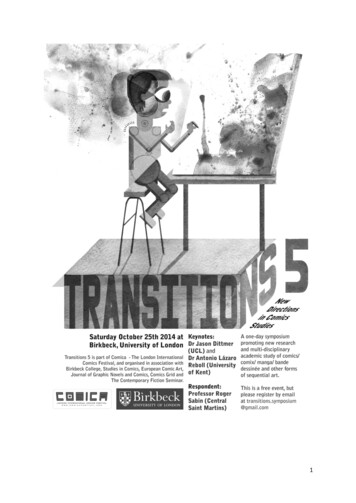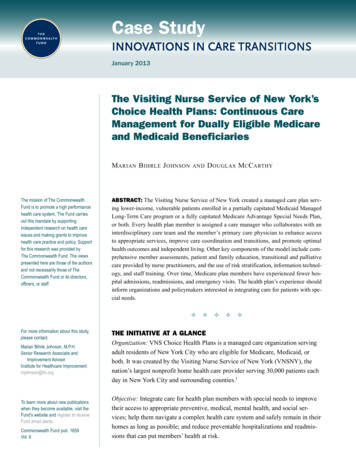
Transcription
1
TRANSITIONS 5 – New Directions in Comics Studies 2014Birkbeck, University of LondonMain Building, Malet Street (entrance Torrington Square)9. 30 - 10REGISTRATION (basement, main building Malet Street)10 - 11 Room: B35 (basement)WelcomeKey Note: Jason DittmerComics as Assemblages: Thinking Topologically and Materially About Graphic Narrativesth11.15-12.15 Room: 630 (6floor)CHARACTERS Chair: NicolaStreetenGrace D. Gipson: MarthaWashington - A ReimaginedBlack American IconMiriamKent:UnveilingMarvelsEssi Varis: Why Charactersmatter11.15-12.15 Room: B35(Basement)SOUND AND COLOUR Chair:John MiersBarbara Uhlig: Colour inLorenzo Mattotti’s comicsPaddy Johnston: Colour inBryan Lee O’Malley’s comicsDaniel Goodbrey: Sound inweb-comics12.15-12.3012.30-1.30 pm Room: 630CREATORS Chair: RebeckaKlettethFred Francis: The 19 CenturyBackground to Frank Miller’sBatmanChris Thompson: HuntEmerson and the birth of theFortean TimesMartin Flanagan:‘Half Gandalf, Half Mr. Kipling’:The Marvel and DC Work ofPaul Cornell2.15 – 3 Room B3512.30-1.30 pm Room: B04SPACESOFREPRESENTATIONChairXavier Marco Del PontEdward Jackson: Melodramasof Precorporation: Kurt Cobainin ComicsEmmaHayward:Remembering New York inJulius Knipl: Real EstatePhotographerDaniel King:TheCraftingofQueerDomestic Space in JaimeHernandez's Love and RocketsLUNCHKey Note: Antonio Lázaro-RebollComics Culture and Comic Art Scholarship in Spain (1965-1975)3 – 3.15Break3.15-4.15 Room: B35What we talk about when we talk about comicsstudies Chair: Ernesto PriegoIan Horton: Info-Comics, Science (Fiction) andPublic RelationsAhmed Jameel:Rethinking collaborationAnn D’Orazio: The Matter of Comics Studies4 .15– 4.454.45-5.45 Room: B35HISTORIES Chair: Paul GravettAnn Miller: Binet’s L’Institution: The First FrenchComics Autobiography?Marisol Rodriguez: El Libro VaqueroRik Spanjers: Questioning the Nazi Past ThroughHandwriting and Composed Text in Peter Pontiac’sKraut5.45 – 6 pm6 - 6.30Break12.30 – 1.30 pm Room: B35PORNOGRAPHIC COMICSChair: Caroline WaltersJude Roberts: Savita Bhabhi,Indian on-line pornographiccomicsAnna Madill: Boys LoveComics and legislationSina Shamsavari: AlternativeGay Porno Comics1.30 – 2.15 pm11.15-12.15 Room: B04(basement)COMICS AND MENTALHEALTH Chair: Pen MendoncaIan Williams: On Justin GreenMegan John Barker, CarolineWaters and Joseph DeLappe: Mental health in comics3.15-4.15 Room: B04DISSIDENCE Chair Maggie GrayKatherine Hubbard: ‘You like that, you godamnedqueer?’ Psychology, gender and sexuality in Moore& Gibbons’ WatchmenJoseph Willis: Female Sex and Sexual Identity inthe Superhero Narrative’Christina Scholtz: Trans identities in Dial H andBatgirlBreak4.45-5.45 Room: B04IDENTITÉ Chair: Tara-Monique EtheringtonArezoo Adibeik:The (re)presentation of Self and Others in TheAdventures of TintinXavier Marco Del Pont: You All Look the Same toMe: Doubling and Incest in Bande DessinéeRebecka Klette: Other’-ness and Hyper-realityBreakCOMMENTS BY OUR RESPONDENTS FOLLOWED BY WINE RECEPTION IN B042
TRANSITIONS 5 – New Directions in Comics StudiesKeynotes: Dr. Jason Dittmer (UCL, Captain America & the Nationalist Superhero); Dr.Antonio Lázaro-Reboll (University of Kent)Respondents: Professor Roger Sabin (Central Saint Martins, Comics, Comix & GraphicNovels); Dr Joan Ormrod (Manchester Metropolitan University, Journal of Graphic Novels &Comics); Dr Julia Round (Bournemouth University; Studies in Comics)Respondents:Roger Sabin is Professor in Popular Culture at Central Saint Martins, University of the ArtsLondon. His research interests encompass cultural history, cultural ctudies, and subculturalstudies.He specialises in comics, graphic novels, and manga; marginalised andunderground literature/graphics/film; punk and counter-culture; comedy; television crimedrama; the 19th century entertainment industry (music hall, penny press, etc.); and culturaltheory, especially postmodernism in history.Joan Ormrod is a senior lecturer in film and media studies at the Manchester School of Art,Manchester Metropolitan University. She researches women in comics and subculturalidentities. She is currently writing a book on Wonder Woman which examines cultural,political and social influences upon the representation of the human body from the 1940s ,and is also editing a book with Dr Matthew Jones of UCL in time travel in the media. She coedits Routledge's Journal of Graphic Novels and Comics with David Huxley.Julia Round is a senior lecturer in the Media School at Bournemouth University. She haspublished and presented work internationally on cross-media adaptation, television anddiscourse analysis, the application of literary terminology to comics, the 'graphic novel'redefinition, and the presence of gothic and fantastic motifs and themes in this medium. Herbook, Gothic in Comics and Graphic Novels, was published this year by McFarland. She coedits the Intellect journal Studies in Comics with Chris Murray.Part of Comica – The London International Comics Festival, this is currently the only regularacademic comics event based in London. Transitions is devoted to promoting new researchinto comics in all their forms, aiming specifically to provide a forum for research bypostgraduate students and early career lecturers/researchers. By deliberately not appointinga set theme, we hope to put together a programme reflecting the diversity of comics studies.Comics studies encourage cross-disciplinary pollination and a convergence of distinctknowledges: literary and cultural studies, visual arts and media, modern languages,sociology, geography and more. By thinking about comics across different disciplines, wehope to stimulate and provoke debate and to address a wide spectrum of questions, to mapnew trends and provide a space for dialogue and further collaboration.Supported by Comica, The Centre for Contemporary Literature (Birkbeck), and theContemporary Fiction SeminarThanks to John Miers for a great poster3
Keynotes:Comics as Assemblages: Thinking Topologically and Materially About GraphicNarrativesDr Jason Dittmer (UCL)In this paper I outline assemblage theory and trace its relevance to comics studies. I arguethat this approach offers the possibility of integrating the various disciplinary strands ofcomics studies: the discursive, the visual, the material, and so on. I do so via empiricalreference to the recent Hypercomics exhibition at Battersea Park, Chris Ware’s ‘BuildingStories’, and the comics scene in Cambodia. These varied engagements with comics-asassemblage illustrate the way in which comics are always a precarious encounter betweenartists, writers, and audiences, mediated by a material form that is itself a precariousachievement.Jason Dittmer is Reader in Human Geography at University College London. He is the editorof Comic Book Geographies (Franz Steiner, 2014) and the author of Captain America andthe Nationalist Superhero: Metaphors, Narratives, and Geopolitics (Temple University Press,2013). His current research is on everyday diplomacies and the production of geopoliticalassemblages.Comics Culture and Comic Art Scholarship in Spain (1965-1975)Dr Antonio Lázaro-Reboll (University of Kent)This talk maps the formation of comics culture and comic art scholarship in Spain from 1965to 1975, focusing on a local scene created by comics authors, media critics and fan writerswho forged international networks with contemporary comics book cultures in Europe andthe United States. Focusing on pioneering studies, specialist publications and fanzines, itexamines how the adoption of American and European theoretical explorations of massmedia phenomena was applied to the study of comics, comics-related phenomena and otherpopular cultural forms. The Spanish case is discussed in relation to contemporary comicsbook cultures in Europe and the United States exploring transnational relationships andcultural exchanges.Antonio Lázaro-Reboll is a Senior Lecturer in Hispanic Studies at the University of Kent. Heis the author of Spanish Horror Film (Edinburgh University Press, 2012) and the co-editor(with Andrew Willis) of Spanish Popular Cinema (Manchester University Press, 2004). Hisresearch interests are in Spanish cultural studies and film studies, especially Spanishpopular film, the development of film cultures in Spain (reception, consumption and fandom),and the cross-cultural dialogue between Spain and other world cinemas (internationaltraditions of the horror genre, global psychotronic culture). He is currently working on theemergence of subcultural modes of production, reception and consumption in Spain in the1970s across different media (film, comics, magazines) and their relation to two keymoments of recent Spanish history, late Francoism and the Transition.4
Panels:The construction of ethnic identities in comic books: A Critical Discourse Analysis ofthe (re)presentation of Self and Others in The Adventures of Tintin(Arezoo Adibeik, Lancaster University)The bulk of literature highlights the semiotics of visual racism, their relevant discourses andmultimodal realisations (e.g. Richardson and Wodak, 2009; Wodak and Reisigl, 2000;Wodak and Van Dijk, 2000). For the past three decades, the emergence of power andideology in comic books has triggered much interest in multimodal analysis from a sociocultural point of view (e.g. Dorfman and Mattelart, 1975; Barker, 1989). While political comicsand comic book volumes have been explored for their multimodal and semiotic aspects inrecent years (e.g. Wodak and Forchtner, 2014; Forceville, 2011; Van Leeuwen andSuleiman, 2010; Mizushima and Stapleton, 2006), the (re)presentation of different ethnicidentities in a complete comic book series has been less under scrutiny from a criticaldiscursive point of view. In particular, little research has been conducted on therepresentation of Self and Others in a comic book genre such as The Adventures of Tintin.These books as one of the most controversial and widely distributed comic book series inthe past century is still of interest among people with different linguistic and non-linguisticbackgrounds. Since its first appearance in 1929, the series have sold over 200 million copiesin more than 70 languages (Farr, 2007; Rifas, 2012). Despite their public interest, the serieshave been frequently accused of promoting racial stereotypes in recent years (e.g. thestereotypical depictions of Africans).This paper explores the discursive and multimodal construction of the most frequentlyoccurring South Asians and Middle Easterners, specifically focussing on ethnic stereotypes(e.g. fakirs and emirs) in these adventures. I apply the theoretical insights from the sociosemiotic approach (Kress and Van Leeuwen, 1996, 2006; Van Leeuwen, 2008) with theDiscourse Historical Approach (Reisigl and Wodak, 2001) in order to explore and understandthe patterns of discursive and visual racism within images and texts via both quantitative andqualitative methods.Mental Health in Comics(Meg John Barker [Open University], Dr Caroline Walters [Middlesex], Joseph De Lappe[Open University])Many of the most acclaimed comics, and related tie-ins, utilise themes and characters thatdirectly or indirectly touch on mental health. They often do this in ways that are thoughtful,challenging and provocative but also have the potential to be manipulative, voyeuristic andstereotypical. Key examples of depictions of mental health in well known comics are thecharacters of Delirium and Despair in Neil Gaiman’s Sandman series, and the Joker in bothChristopher Nolan’s Dark Knight Trilogy of films and in the Scott Snyder helmed Death of theFamily story arc that recently ran across the Batman DC comics. At the same time, the riseof media such as web comics, and alternatives to the classic comic genres whichincorporate memoir, journalism and social history indicate the potential of comics to portraylived experience in vivid tones. Questions that we examine include: Does the representationof often deeply personal feelings, both painful and joyous, as expressed by individuals withtheir own experiences of mental health issues connect collectively? Can we identify sharedthemes and concerns in the work of comic artists who are concerned with, or, who haveexperience of mental health issues?This paper will draw on the experiences of the three contributors of putting together aworkshop on comics and mental health, and a special issue of Asylum Magazine, which is anon-traditional journal for anyone interested in mental health and psychiatry.5
The Matter of Comics Studies(Ann D’Orazio, University of New Mexico)Comics Studies is no longer fighting for legitimacy as an academic field. As Comics Studiescontinues to grow, a canon has emerged and certain discourses and accepted narratives ofhow to approach comics have begun to dominate. While these approaches have much tooffer, they often rely upon treating comics in some problematic ways. Some approaches callfor treating comics as literature; others analogize the emergence and growth of comics to theexplosion of American film in the early twentieth century; still others see comics as part of akind of global genre turn away from the novel, as the novel purportedly once did from theepic. These approaches often valorize the single-creator independent mode of production.Rather than focusing upon the collaborative nature of comics—or what is typical of and incomics, i.e. the conventions of genre comics—these approaches end up missing andignoring the bulk of comics produced.This paper seeks to argue for an approach to Comics Studies that takes a longer historicaland cultural view, drawing upon promiscuous readings of the work of David Kunzle, CharlesHatfield, and Thierry Groensteen for support. In this paper, I argue that in order for ComicsStudies to avoid replicating the ossified structures imposed upon Art History, Literature, andFilm Studies, scholars must avoid total obedience to the paradigms found within thesedisciplines, and treat co
01.08.2013 · Comics as Assemblages: Thinking Topologically and Materially About Graphic Narratives 11.15-12.15 Room: . Gay Porno Comics 12.30-1.30 pm Room: B04 SPACES OF REPRESENTATION Chair Xavier Marco Del Pont Edward Jackson: Melodramas of Precorporation: Kurt Cobain in Comics Emma Hayward: Remembering New York in Julius Knipl: Real Estate Photographer Daniel King: The











